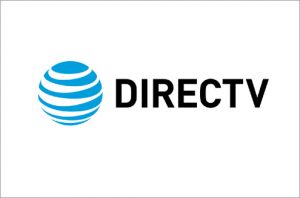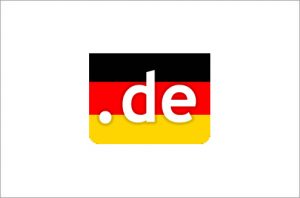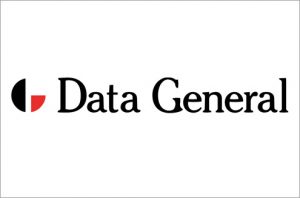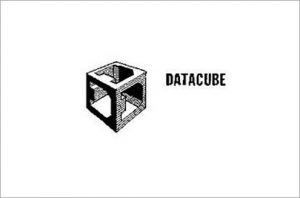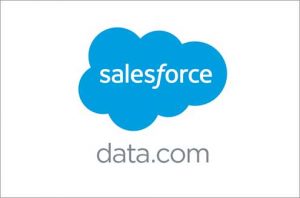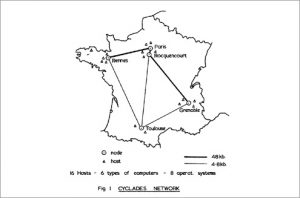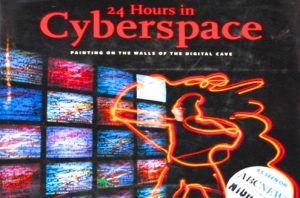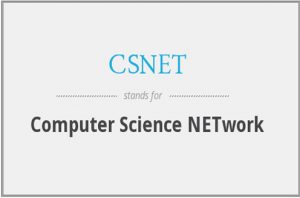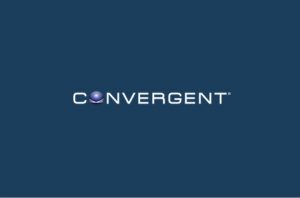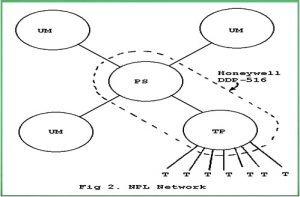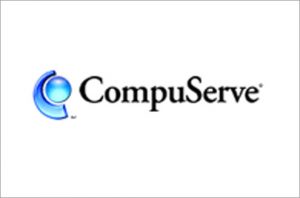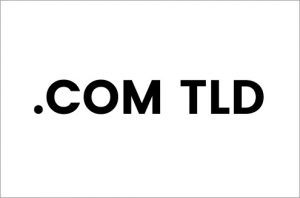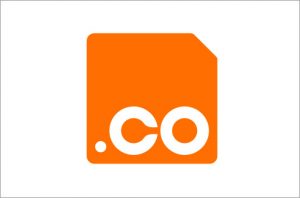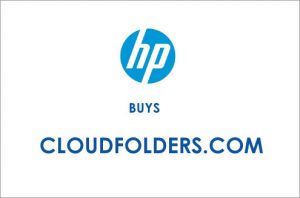On December 11, 1986, Data General corporation registered the dg.com domain name, making it 49th .com domain ever to be registered.
Data General was one of the first minicomputer firms from the late 1960s. Three of the four founders were former employees of Digital Equipment Corporation. Their first product, the Data General Nova, was a 16-bit minicomputer. This used their own operating system, Data General RDOS (DG/RDOS), and in conjunction with programming languages like “Data General Business Basic” they provided a multi-user operating system with record locking and built-in databases far ahead of many contemporary systems. The Nova was followed by the Supernova and Eclipse product lines, all of which were used in many applications for the next two decades. The company employed an Original Equipment Manufacturer (OEM) sales strategy to sell to third parties who incorporated Data General computers into the OEM’s specific product lines. A series of missteps in the 1980s, including missing the advance of microcomputers despite the launch of the microNOVA in 1977, and the Data General-One portable computer in 1984, led to a decline in the company’s market share. The company did continue into the 1990s, however, and was eventually acquired by EMC Corporation in 2002.
Company History
Origin, founding and early years: Nova and SuperNova
Data General (DG) was founded by several engineers from Digital Equipment Corporation who were frustrated with DEC’s management and left to form their own company. The chief founders were Edson de Castro, Henry Burkhardt III, and Richard Sogge of Digital Equipment (DEC), and Herbert Richman of Fairchild Semiconductor. The company was founded in Hudson, Massachusetts in 1968. Edson de Castro was the chief engineer in charge of the PDP-8, DEC’s line of inexpensive computers that created the minicomputer market. It was designed specifically to be used in laboratory equipment settings; as the technology improved, it was reduced in size to fit into a 19-inch rack. Many PDP-8’s still operate today, decades later. De Castro, convinced he could do one better, began work on his new 16-bit design. The result was released in 1969 as the Nova. Designed to be rack-mounted similarly to the later PDP-8 machines, it was smaller in height and ran considerably faster. Launched as “the best small computer in the world”, the Nova quickly gained a huge following, especially in scientific and educational markets, and made the company flush with cash, although Data General had to defend itself from misappropriation of its trade secrets. With the initial success of the Nova, Data General went public in the fall of 1969. The Nova, like the PDP-8, used a simple accumulator-based architecture. It lacked general registers and the stack-pointer functionality of the more advanced PDP-11, as did competing products, such as the HP 1000; compilers used hardware-based memory locations in lieu of a stack pointer.
The original Nova was soon followed by the faster SuperNova, then later by several minor versions based on the SuperNova core. The last major version, the Nova 4, was released in 1978. During this period the Nova generated 20% annual growth rates for the company, becoming a star in the business community and generating US$ 100 million in sales in 1975. In 1977, DG launched a 16-bit microcomputer called the microNOVA to poor commercial success. The Nova series plays a very important role as instruction-set inspiration to Charles P. Thacker and others at Xerox PARC during their construction of the Xerox Alto.
Late 1970s to late 1980s: crisis and a short term solution
In 1974, the Nova was supplanted by their upscale 16-bit machine, the Eclipse. Based on many of the same concepts as the Nova, it included support for virtual memory and multitasking more suitable to the small office environment. For this reason, the Eclipse was packaged differently, in a floor-standing case resembling a small refrigerator. Production problems with the Eclipse led to a rash of lawsuits in the late 1970s. Newer versions of the machine were pre-ordered by many of DG’s customers, which were never delivered. Many customers sued Data General after more than a year of waiting, charging the company with breach of contract, while others simply canceled their orders and went elsewhere. The Eclipse was originally intended to replace the Nova outright, evidenced by the fact that the Nova 3 series, released at the same time and utilizing virtually the same internal architecture as the Eclipse, was phased out the next year. Strong demand continued for the Nova series, resulting in the Nova 4, perhaps as a result of the continuing problems with the Eclipse. In 1976, Digital announced the VAX series, their first 32-bit minicomputer line, described as “super-minis”. The first products would not ship until February 1978. This coincided with the aging 16-bit products, which were coming due for replacement. Data General immediately launched their own 32-bit effort in 1976 to build what they called the “world’s best 32-bit machine”, known internally as the “Fountainhead Project”. When Digital’s VAX-11/780 was shipped in February 1978, however, Fountainhead was not yet ready to deliver a machine, due mainly to problems in project management. DG’s customers left quickly for the VAX world.
Soon afterwards, Data General launched a hyperactive 32-bit effort based on the Eclipse known as the “Eagle Project”. By late 1979, it became clear that Eagle would deliver before Fountainhead, igniting an intense turf war within the company for constantly shrinking project funds. In the meantime, customers abandoned Data General in droves, driven not only by the delivery problems with the original Eclipse (including very serious quality control and customer service problems), but also the power and versatility of Digital’s new VAX line. The Eagle Project was the subject of Tracy Kidder’s Pulitzer prize-winning book, The Soul of a New Machine, making the MV line the best-documented computer project in recent history. The MV/8000 was a straightforward, 32-bit extension of the Nova-based Eclipse, yet still lacking a hardware stack pointer adopted by most new computers since the late 1960s. It was backwards-compatible with 16-bit Eclipse applications, used the same command-line interpreter as the 16-bit Eclipse, and achieved improved 32-bit performance over the VAX 11/780 while using fewer components.
Software
Data General developed operating systems for its hardware: DOS and RDOS for the Nova, RDOS and AOS for the 16-bit Eclipse C, M, and S lines, AOS/VS and AOS/VS II for the Eclipse MV line, and a modified version of System V Unix called DG/UX for the Eclipse MV and AViiON machines. The AOS/VS software was the most commonly used DG software product and included CLI (Command Line Interpreter) allowing for complex scripting, DUMP/LOAD, and other custom components.
Related system software also in common use at the time included such packages as X.25, Xodiac, and TCP/IP for networking, Fortran, COBOL, RPG, PL/I, C and Data General Business Basic for programming, INFOS II and DG/DBMS for databases, and the nascent relational database software DG/SQL.
Data General also offered an office automation suite named Comprehensive Electronic Office (CEO), which included a mail system, a calendar, a folder-based document store, a word processor, a spreadsheet processor, and other assorted tools. All were crude by today’s standards but were revolutionary for their time. Some software development from the early 1970s is notable. PLN (created by Robert Nichols) was the host language for a number of DG products, making them easier to develop, enhance, and maintain than macro assembler equivalents. PLN smacked of a micro-subset of PL/1, in sharp contrast to other languages of the time, such as BLISS. The RPG product (shipped in 1976) incorporated a language runtime system implemented as a virtual machine which executed pre-compiled code as sequences of PLN statements and Eclipse commercial instruction routines. The latter provided microcode acceleration of arithmetic and conversion operations for a wide range of now-arcane data types such as overpunch characters. The DG Easy product, a portable application platform developed by Nichols and others from 1975 to 1979 but never marketed, had roots easily traceable back to the RPG VM created by Stephen Schleimer. Also notable were several commercial software products developed in the mid to late 1970s in conjunction with the commercial computers. These products were popular with business customers because of their screen design feature and other ease-of-use features. The first product was IDEA (Interactive Data Entry/Access) which consisted of a screen design tool (IFMT), TP Controller (IMON) and a program development language (IFPL). The second was the CS40 line of products which used COBOL and their own ISAM data manager. The COBOL variant used included an added screen section. Both of these products were a major departure from the transaction monitors of the day which did not have a screen design tool and used subroutine calls from COBOL to handle the screen. IDEA was identified by some market watchers as a precursor to fourth-generation programming languages.
The original IDEA ran on RDOS and would support up to 24 users in an RDOS Partition. Each user could use the same or a different program. Eventually IDEA ran on every commercial hardware product from the MicroNova (4 users) to the MV series under AOS/VS, the same IDEA program running all those systems. The CS40 (the first of this line) was a package system which supported four terminal users, each running a different COBOL program. These products also led to the development of a third product, TPMS (Transaction Processing Monitoring System (announced in 1980)) which could capably run a large number of COBOL or PL/I users with a smaller number of processors, a major resource and performance advantage on AOS and AOS/VS systems. TPMS had the same screen design tool as the earlier products. TPMS used defined subroutine calls for screen functions from COBOL or PL/I, which in some users’ eyes made it more difficult to use. However, this product was aimed at the professional IS Programmers as were its competitors—IBM’s CICS and DEC’s TRAX. As with IDEA, TPMS used INFOS for information management and DG/DBMS for database management.
Dasher Terminals
Data General produced a full range of peripherals, sometimes by rebadging printers for example, but Data General’s own series of CRT-based and hard-copy terminals, were high quality and featured a generous number of function keys, each with the ability to send different codes, with any combination of control and shift keys, which influenced WordPerfect design. The model 6053 Dasher 2 featured an easily tilted screen, but used many integrated circuits; the smaller, lighter D100, D200 and eventually the D210 replaced it as the basic user terminal, while graphics models such as the D460 (with ANSI X3.64 compatibility) occupied the very high end of the range. Terminal emulators for the D2/D3/D100/D200/D210 (and some features of the D450/460) do exist, including the Freeware 1993 DOS program in D460.zip.
Most Data General software was written specifically for their own terminals (or the terminal emulation built into the Desktop Generation DG10, but the Data General One built-in terminal emulator is not often suitable), although software using Data General Business BASIC could be more flexible in terminal handling, because logging into a Business BASIC system would initiate a process whereby the terminal type would (usually) be auto-detected.
Desktop Generation
Data General also brought out a small-footprint “Desktop Generation” range, starting with the DG10 that included both Data General and Intel CPUs in a patented closely coupled arrangement, able to run MS-DOS or CP/M-86 concurrently with DG/RDOS, with each benefiting from the hardware acceleration given by other CPU as a co-processor that would handle (for instance) screen graphics or disk operations concurrently. Other members of the Desktop Generation range, the DG20 and DG30, were aimed more at traditional commercial environments, such as multi-user COBOL systems, replacing refrigerator-sized minicomputers with toaster-sized modular microcomputers based around the microECLIPSE CPUs and some of the technology developed for the microNOVA-based “Micro Products” range such as the MP/100 and MP/200 that had struggled to find a market niche. The Single-processor version of the DG10, the DG10SP, was the entry-level machine with, like the DG20 and 30, no ability to run Intel software. Despite having some good features and having less direct competition from the flood of cheap PC compatibles, the Desktop Generation range also struggled, partly because they offered an economical way of running what was essentially “legacy software” while the future was clearly either slightly cheaper Personal Computers or slightly more expensive “super minicomputers” such as the MV and VAX computers.
Joint venture with Soviet company
On December 12, 1989, DG and Soviet Union software developer NPO Parma announced Perekat, the first joint venture between an American computer company and a Soviet company. DG would provide hardware and NPO Parma the software, and Austrian companies Voest Alpine Industrieanlagenbau GmbH and their marketing group Voest Alpine Vertriebe would build the plant.
Final downturn and EMC takeover
Despite Data General’s betting the AViiON farm on the Motorola 88000, Motorola decided to end production of that line. The 88000 had never been very successful, and DG was the only major customer. When Apple Computer and IBM proposed their joint solution based on POWER architecture, the PowerPC, Motorola picked up the manufacturing contract and killed the 88000. DG quickly responded and introduced new models of the AViiON series based on a true commodity processor, the Intel x86 series. By this time a number of other vendors, notably Sequent Computer Systems, were also introducing similar machines. The lack of lock-in now came back to haunt DG, and the rapid commoditization of the Unix market led to shrinking sales. DG did begin a minor shift toward the service industry, training their technicians for the role of implementing a spate of new x86-based servers and the new Microsoft Windows NT domain-driven, small server world. This never developed enough to offset the loss of high margin server business however.
Data General also targeted the explosion of the internet in the latter 1990s with the formation of the THiiN Line business unit, led by Tom West, which had a focus on creation and sale of so-called “internet appliances”. The product developed was called the SiteStak web server appliance and was designed as an inexpensive website hosting product. CLARiiON did better after finding a large niche for Unix storage systems, and its sales were still strong enough to make DG a takeover target. EMC Corporation, a major data storage company, announced that they would buy Data General and its assets in January 2002 for $1.1 Billion or $19.58 a share.[7] Although details of the acquisition specified that EMC had to take the entire company, and not just the storage line, EMC quickly ended all development and production of DG computer hardware and parts, effectively ending Data General’s presence in the segment. The maintenance business was sold to a third party, who also acquired all of DG’s remaining hardware components for spare parts sales to old DG customers. The CLARiiON line continued to be a major player in the market, and was marketed under that name until January 2012.[8] The Clariion and Celerra storage products evolved into EMC’s unified storage platform, the VNX platform. Data General would be only one of many New England based computer companies, including the original Digital Equipment Corporation that collapsed or were sold to larger companies after the 1980s. On the Internet, even the old Data General domain (dg.com), which contained a few EMC webpages that only mentioned the latter company in passing, was sold to the Dollar General discount department store chain in October 2009.
